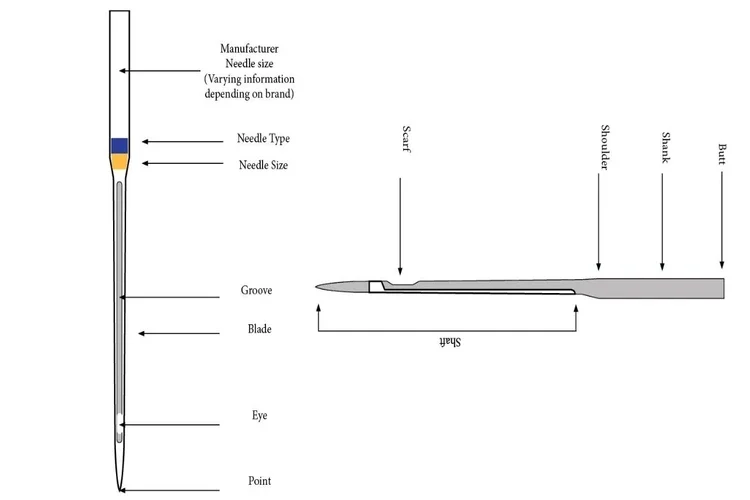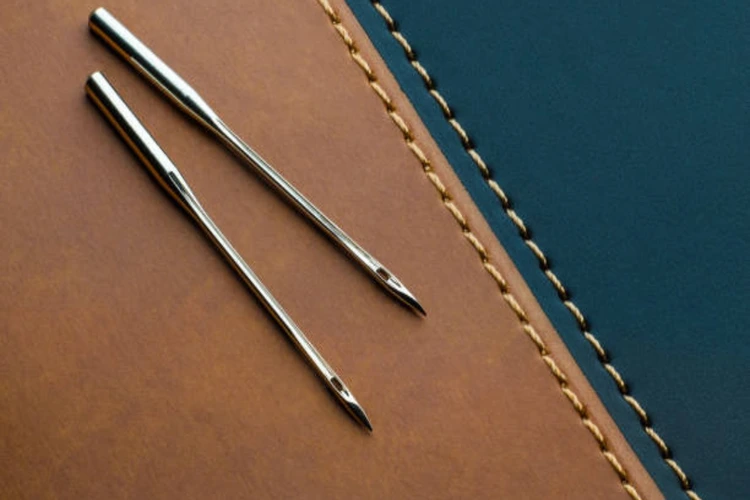What Constitutes a Sewing Machine Needles?
A sewing machine needle is specifically made to be inserted into an electronic sewing machine. It’s designed with a pointed tip that includes a hole for threading, and a blunt top with a rounded front and flat back. After insertion, it’s secured in place using a screw within the machine.
Parts of Sewing Machine Needles
- Butt: This part is inserted into the sewing machine clamp.
- Shank: The front of the needle has a rounded shape, while the back is flat, helping with proper insertion into the machine.
- Shaft: It denotes the length of the needle.
- Eye: This is where the thread is inserted.
- Tip: The pointed end of the needle.

Selecting the Right Sewing Machine Needles Size
- Thickness: Sewing machine needles size vary depending on the needle’s thickness. Thicker needles are adept at sewing through heavier fabrics, while thinner ones are more suitable for delicate materials like silk and chiffon.
- Purpose: Needles are tailored for specific tasks such as sewing stretch fabrics, topstitching, or handling denim. Leatherwork requires specialized needles due to its dense nature. Furthermore, different fabrics and tasks may call for needles with different tip shapes to ensure optimal penetration of the fabric fibers.
What is the Significance of Numbers in Sewing Machine Needles Size?
- On most needle packaging, you’ll find two numbers separated by a slash, such as 80/12. The smaller number corresponds to the American size system, ranging from 8 to 20, while the larger number represents the European size system, ranging from 60 to 120. European numbers indicate the diameter of the needle, with a 1mm diameter needle labeled as 100. In essence, a higher number indicates a thicker sewing machine needle. Choose smaller needle sizes for lightweight fabrics and larger sizes for heavyweight fabrics.
Typical Sewing Machine Needles Size
| European | US Size | Labelling |
| 60 | 8 | 60/8 |
| 65 | 9 | 65/9 |
| 70 | 10 | 70/10 |
| 75 | 11 | 75/11 |
| 80 | 12 | 80/12 |
| 90 | 14 | 90/14 |
| 100 | 16 | 100/16 |
| 110 | 18 | 110/18 |
The numbers on sewing machine needle packages indicate the thickness of the fabric the needles can handle. Higher numbers are suitable for sewing thicker fabrics, while lower numbers are intended for finer fabrics. For example, a 60/8 needle is ideal for sewing delicate fabrics like silk and organza, whereas a 110/18 needle is better suited for denim and canvas.
Which Sewing Machine Needles Size Are Appropriate for My Project?
- Size 8/60, 9/65, 10/70 – (Very fine fabrics) These sizes are suitable for delicate materials like fine silk, chiffon, organza, voile, and intricate lace.
- Size 11/75, 12/80 – (Lightweight fabrics) Recommended for lightweight materials such as cotton voile, silk, synthetics, spandex, and lycra.
- Size 14/90 – (Medium weight fabrics) Ideal for medium-weight fabrics including quilting fabrics, cotton, velvet, fine corduroy, linen, muslin, jersey, tricot, knits, light wool, and fleece.
- Size 16/100 – (Heavyweight fabrics) Designed for heavy fabrics like denim, corduroy, canvas, heavy linens, twill, duck, suiting, and leather.
- Size 18/110 – (Very heavy fabrics) Intended for extremely heavy materials such as heavy denim, canvas, upholstery fabric, and faux fur.
Types Of Sewing Machine Needles
- Universal Sewing Machine Needles
These needle types are commonly used and versatile, suitable for sewing various fabrics ranging from woven to stable knits with minimal stretch. They work well with both natural and synthetic materials, making them ideal for sewing cotton, voile, linen, light wool, rayon, and poplin. Investing in assorted sewing machine needle sizes from 10/70 to 14/90 ensures coverage for a wide range of fabric types. Universal needles are characterized by their slightly rounded tips.
- Ball Point Needles
Ballpoint needles are ideal for tightly woven fabrics and knit fabrics with less stretch. They’re effective with cotton knits, polyester, and polyester-cotton blends. Featuring a rounded tip, they glide through fibers without cutting them, crucial for preventing holes in stretch fabrics.
- Jersey Needles
These needles are designed specifically for knit fabrics with a moderate stretch. Their rounded tips are engineered to move smoothly between fibers without causing laddering or holes.
- Stretch Needles
These needles are designed for fabrics with maximum stretch, such as dance lycra, spandex, and swimwear material. They are also well-suited for sewing elastics and rib knits, effectively reducing puckering and skipped stitches in stretch seams.
- Leather Needles
Leather needles are crucial for sewing leather, synthetic suede, faux leather, or vinyl. With their sharp points and reinforced shafts, these needles effortlessly pierce through tough materials. Adjusting the stitch length when using a leather needle is vital to prevent unnecessary perforations in the fabric.
- Quilting Needles
Quilting needles are strengthened to pierce through numerous layers of fabric and batting, preventing breakage or bending. They are especially useful for bag-making projects that require sewing through thicker interfacing and multiple layers.
Jeans Needles (Denim Needles)
These needles are crafted specifically for sewing denim, renowned for its thickness and density. Typically available in thicker sizes, they’re well-equipped for heavy-duty tasks such as stitching jeans or overalls. Featuring a sharp point, they effortlessly penetrate through the layers of thick fabric.
- Machine Embroidery Needles
These sewing machine needles are specifically crafted for computerized embroidery machines, especially for dense stitching requirements. They excel at preventing splitting or shredding of the machine embroidery thread, guaranteeing smooth and consistent stitches.
You may also like:
- The History Of Sewing Machine
- Using a Seam Ripper: A Step-by-Step Guide
- Different Types of Sewing Machines
- Sewing Kits: A Comprehensive Guide
- Sewing Machine Parts And Functions
- Count of Yarn: Explanation and Varieties
- Yarn Manufacturing Process
- Varieties of Woven Fabrics and Their Applications
- Non Woven Geotextile Fabric
- What is Sisal Fiber? Properties, Structure, and How It Made?
Share this Article!

